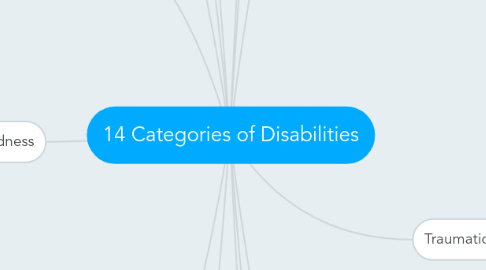
1. Visual Impairment
1.1. Braille
1.2. Preferential seating
1.3. Handouts containing pertinent information
1.4. Increase visual clarity
1.5. Video Magnifiers
1.6. Braillewriter
1.7. Audio books
2. Speech and Language Impairment
2.1. Have easy and good interactive communication in classroom
2.2. Provide a quiet spot for the student to work if possible
2.3. Be patient when student is speaking, since rushing may result in frustration
2.4. Speech and Language therapy should be given
2.5. Use of pacing boards to pace sentences
2.6. Use of AAC
2.7. Use of assistive technology such as Ipads
3. Intellectual Disability
3.1. Description: Significant subaverage general intelligence.
3.2. Intervention/Modifications: Quiet Work Space, Functional Activities, Repetition, Hands-on Learning, etc.
3.3. Assistive Technology: Electronic Wheelchair, Word Processor, Computer
4. Deafness
4.1. Use of amplification devices
4.2. Use of Visuals
4.3. Cochlear implants
4.4. Lip Reading
4.5. Sign Language
4.6. Visual or Vibrating Alerting Devices
4.7. Closed captioning
5. Deaf-Blindness
5.1. Tactile learning strategies (e.g. touch cues, hang-over-hand guidance, hand-under-hand guidance)
5.2. Intervention must be individualized
5.3. Use Sign Language or Braille
5.4. Assistive technology such as Ipads and Braille Note
5.5. https://www.youtube.com/watch?v=GkthqXO9IQM
6. Other Health Impairment
6.1. Sub Categories
6.1.1. • ADD and AH/HD
6.1.2. Diabetes
6.1.3. Epilepsy
6.1.4. Heart conditions
6.1.5. Hemophilia
6.1.6. Lead poisoning
6.1.7. Leukemia
6.1.8. Nephritis
6.1.9. Rheumatic fever
6.1.10. Sickle cell anemia
6.1.11. Tourette syndrome
6.2. Teach physical independence, including mastery of daily living skills
6.3. Teach communication skills
6.4. Post rules, schedules, and assignments
6.5. Teach tools and strategies for calming down
6.6. Teach self-monitoring skills
7. Orthopedic Impairment
7.1. Assistive Technology
7.1.1. speech recognition software
7.1.2. screen reading software
7.1.3. augmentative and alternative communication devices (such as communication boards)
7.1.4. academic software packages for students with disabilities
7.2. Awareness of medical condition and its affect on the student (such as getting tired quickly)
7.3. Securing suitable augmentative communication and other assistive devices
7.4. Instruction focused on development of gross and fine motor skills
7.5. Special seating arrangements to develop useful posture and movements
8. Hearing Impairment
8.1. Alternative curriculum
8.2. Provide extra practice
8.3. Educational interpreter
8.4. Enhance speech-reading conditions (avoid hands in front of face, mustaches well-trimmed, no gum chewing)
8.5. Reduce visual distractions
8.6. Reduce auditory distractions (background noise)
8.7. Obtain student’s attention prior to speaking
8.8. Specialized seating arrangements
8.9. Personal hearing device
9. Developmental delay
9.1. Speech and Language therapy that focuses on expressive and receptive language expansion
9.2. Teach clear speech strategies
9.3. Use activities that are of the child’s interest
9.4. Break down tasks into smaller steps
9.5. Use visual aids
9.6. Give students blocks, clay, paper, pencils, crayons, safety scissors, play dough, and manipulatives to use
9.7. https://www.youtube.com/watch?v=0Zosc8dEBf8
10. Emotional Disturbance
10.1. Disorders
10.1.1. psychotic disorders
10.1.2. obsessive-compulsive disorder (OCD)
10.1.3. eating disorders
10.1.4. conduct disorders
10.1.5. bipolar disorder (sometimes called manic-depression)
10.1.6. anxiety disorders
10.2. Interventions and Assistive Technology
10.2.1. Extend the amount of time that a student is given to complete a particular task.
10.2.2. Break down assignments into smaller ones
10.2.3. Follow low-interest activities with high interest activities so that students get breaks from difficult or less interesting activities from time to time
10.2.4. Plan short review lessons or readiness activities to help orient the student to a particular learning task
10.2.5. Set clear expectations
10.2.6. Explicitly and frequently teach social rules and skills
10.2.7. Model appropriate responses to social situations
10.2.8. Use self-monitoring checklists that the student can use to check off activities as completed
10.2.9. Teach student to accurately label his / her own emotions
10.2.10. Teach student to accurately label the emotional status of others (based on facial cues, verbal cues, etc.)
10.2.11. Use assistive technology such as The Talklight and a Behavior Chart
11. Traumatic Brain Injury
11.1. https://www.youtube.com/watch?v=BAeevSg7vIw
11.2. Assistive Technology such as specialized keyboards and magnified screens, customized chairs, electronic planners and cellphones
11.3. Use verbal praise and encouragement frequently
11.4. Provide immediate feedback and error correction when necessary—feedback should be positive and systematic
11.5. Provide opportunities for student response and practice at an appropriate pace
11.6. Break tasks into small steps and demonstrate each step
11.7. Give clearly stated task directions (limit the number of steps) and ask the student to repeat or paraphrase the directions to ensure understanding
11.8. Provide a simple rationale to help the student understand the relevance of the skill
11.9. Select a meaningful goal or skill the student will need to learn and present it at the level of the student
12. Autism
12.1. Augmentative and Alternative Communication (AAC) Devices
12.2. such as Proloquo2go to assist in communication
12.3. Use a social thinking curriculum to create social awareness and offer strategies for social situations such as working in groups and maintaining eye contact
12.4. Behavior mapping charts assist with analyzing expected and unexpected behaviors
12.5. Group activities/games that encourage the use of wh-questions such as who and what as well as turn taking (e.g. who’s turn is it? What is it?)
12.6. Role-playing
13. Multiple Disabilities
13.1. https://www.youtube.com/watch?v=Yv8IqR_kuEI
13.2. Make sure that everything is relevant to the child you are working with
13.3. Model and practice expected behavior
13.4. Identify clear goals/expectations
13.5. Teach sharing and turn taking
13.6. Use of Augmentative and Alternative Communication such as tangible and tactile symbol systems, choice boards, object prompts and symbols, and physical modeling and prompting
13.7. Anna's Story
13.7.1. https://www.youtube.com/watch?v=Yv8IqR_kuEI

